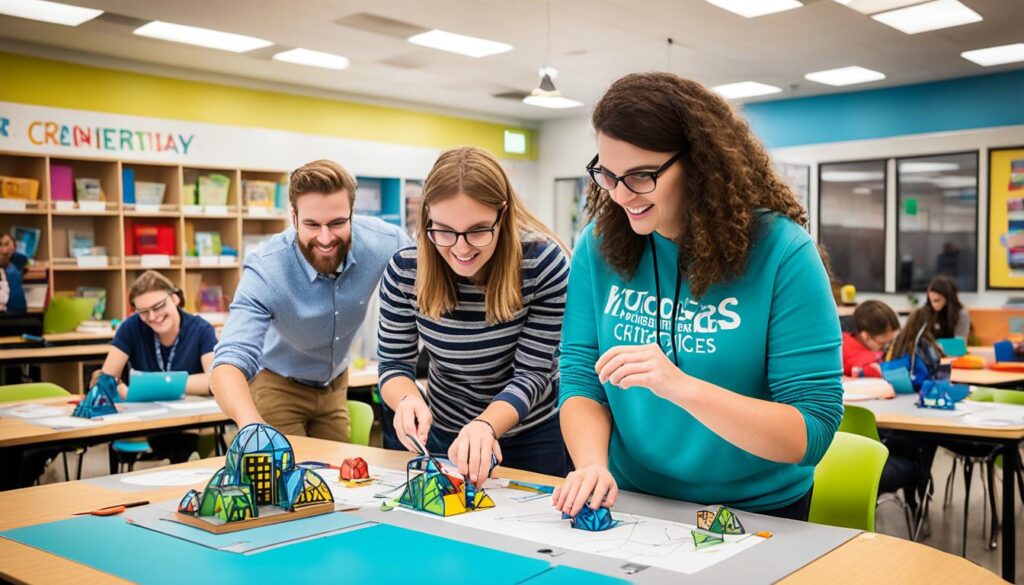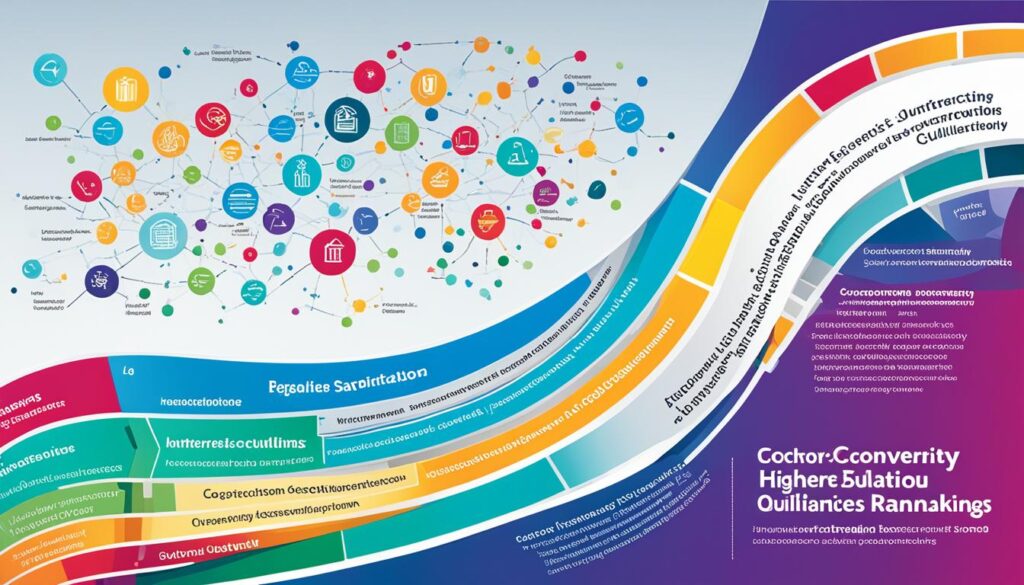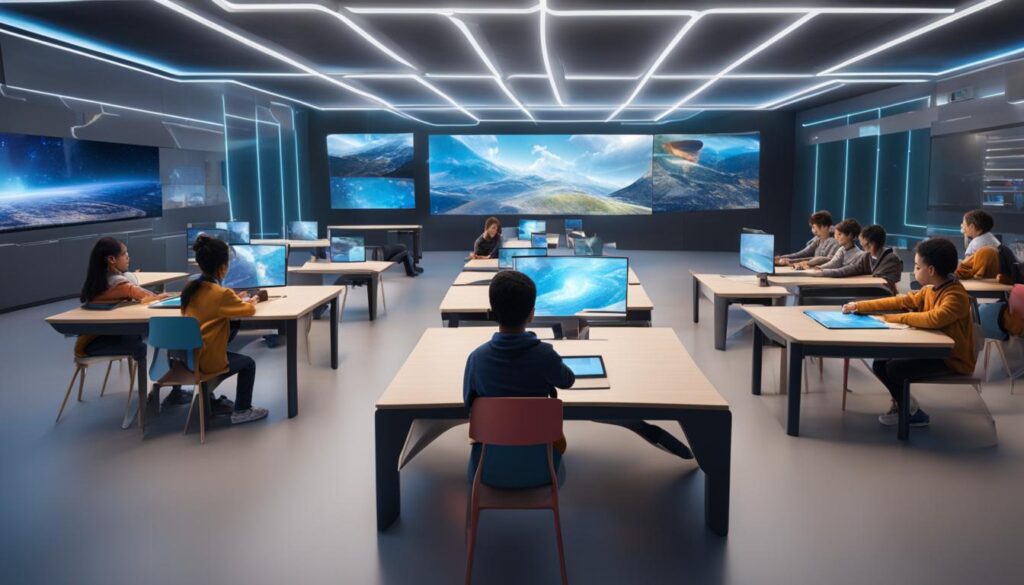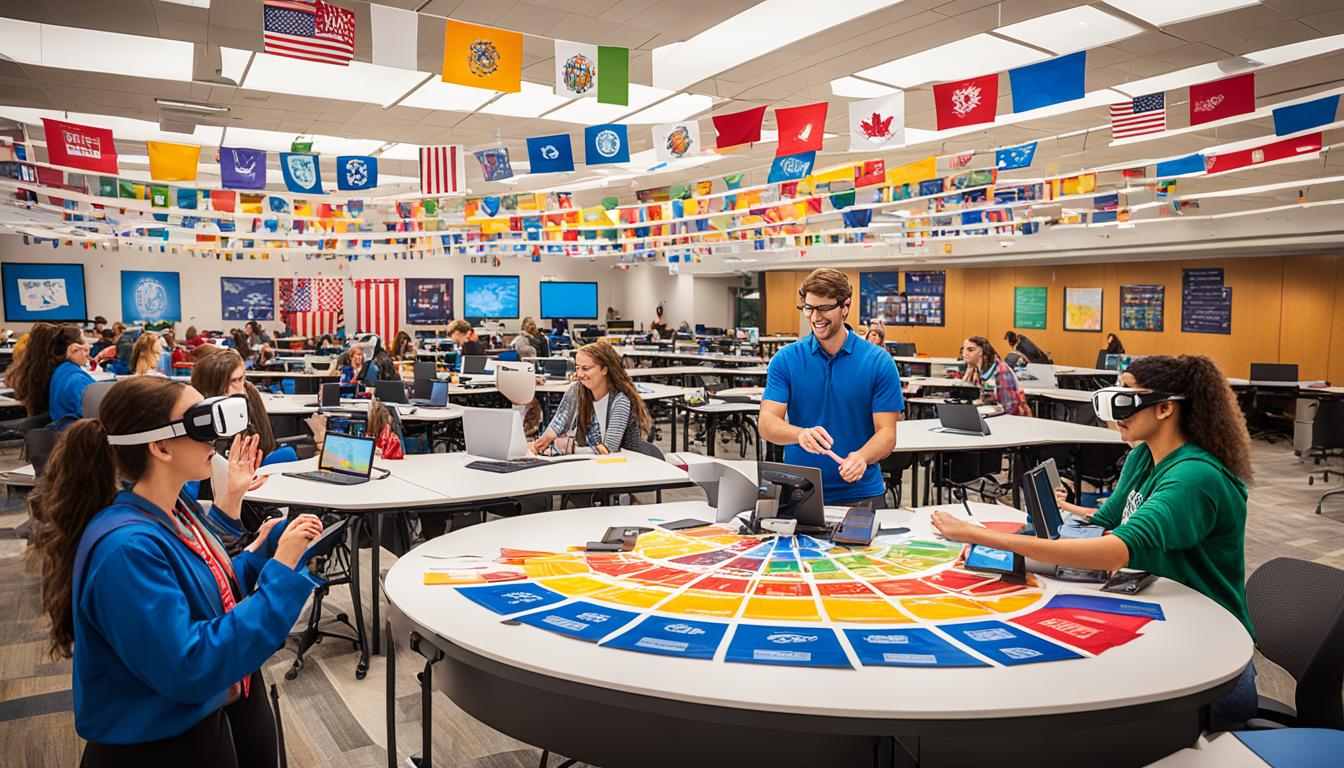Welcome to our blog series on innovations driving excellence in today’s higher education landscape. In this series, we will explore the various factors that contribute to higher education excellence, including university rankings, academic standards, and educational quality. We will delve into the strategies and approaches employed by top universities to maintain their status as centers of academic excellence.
Higher education institutions around the world strive to provide the best learning experiences and opportunities for their students. In an increasingly competitive environment, innovations in teaching, research, and leadership are crucial for universities to stay ahead. By employing innovative approaches, institutions can enhance student success, promote research excellence, and develop future leaders.
In this first section, we will focus on the importance of innovation in higher education and its role in achieving excellence. We will also explore how university rankings and academic standards contribute to measuring educational quality and the recognition of top universities.
Let’s embark on this journey to uncover the incredible innovations driving higher education excellence and discover the strategies that can shape the future of education.
Key Takeaways:
- Higher education excellence is driven by innovations in teaching, research, and leadership.
- University rankings and academic standards play a significant role in determining the status of top universities.
- Innovative approaches are essential for universities to stay competitive and provide the best learning experiences for students.
- Measuring educational quality is crucial for universities, and university rankings help in evaluating their performance.
- Throughout this series, we will explore strategies and best practices for achieving higher education excellence.
The Role of Innovative Teaching Methods in Academic Excellence
In today’s rapidly evolving higher education landscape, the pursuit of academic excellence is crucial for universities and colleges to maintain their competitive edge. One of the key factors driving academic excellence is the adoption of innovative teaching methods that cater to the diverse learning needs of students. By embracing innovative approaches, educational institutions can provide personalized learning experiences that leverage technology, foster collaborative classrooms, and promote active learning.
Personalized Learning Experiences Leveraging Technology
Personalized learning is an educational approach that tailors instruction to individual student needs, interests, and learning styles. It recognizes that each student is unique and embraces technology to create customized learning experiences. Through the use of educational software, digital platforms, and online resources, educators can deliver content that is adapted to students’ abilities and preferences. This individualized approach to learning enhances student engagement, motivation, and mastery of academic concepts. The integration of technology in personalized learning empowers students to take control of their education and facilitates self-paced learning.
Collaborative Classrooms and Active Learning
Collaborative classrooms play a vital role in promoting academic excellence by fostering a sense of community, teamwork, and critical thinking among students. By creating an environment where students actively engage with their peers, educators can cultivate valuable skills such as communication, problem-solving, and creativity. Collaborative learning activities, such as group projects, discussions, and debates, enable students to learn from each other’s perspectives and collectively construct knowledge. This collaborative approach to learning not only enhances academic achievement but also prepares students for real-world challenges where teamwork is essential.
Active learning is another innovative teaching method that promotes academic excellence by encouraging student participation and interaction. Instead of passively consuming information, students are actively involved in the learning process through hands-on activities, simulations, experiments, and real-world applications. This approach deepens students’ understanding of the subject matter, promotes critical thinking, and improves their ability to apply knowledge in practical contexts. By promoting active learning, educators foster a student-centered classroom environment that strengthens academic engagement and outcomes.
| Personalized Learning | Collaborative Classrooms | Active Learning | |
|---|---|---|---|
| Benefits |
|
|
|
Progressive Education Models Enhancing Student Success
In this section, we will explore the role of progressive education models in enhancing student success. These innovative approaches to curriculum design, pedagogy, and assessment prioritize student-centered learning and foster the development of critical thinking, problem-solving, and lifelong learning skills.
One notable progressive education model is personalized learning, which leverages technology to provide students with tailored learning experiences. By customizing learning pathways to suit individual students’ needs and learning styles, personalized learning promotes greater engagement and deeper understanding. It empowers students to take ownership of their education and encourages self-directed learning.

Another aspect of progressive education is the emphasis on collaborative classrooms and active learning. By incorporating group work, discussions, and hands-on activities into the curriculum, students are actively involved in their own learning processes. This collaborative and interactive approach enhances student engagement, fosters effective communication and teamwork skills, and prepares students for real-world challenges.
Furthermore, progressive education models prioritize the development of higher-order thinking skills. Students are encouraged to analyze, evaluate, and think critically about information, rather than simply memorizing facts. This cultivates independent and creative thinking, enabling students to approach complex problems with confidence and curiosity.
Progressive education models are essential for preparing students for success in the modern world. By embracing student-centered approaches and fostering critical thinking abilities, these models empower students to become lifelong learners and adaptable problem solvers.
Overall, progressive education models are instrumental in enhancing student success. They create dynamic learning environments that promote active engagement, collaboration, and critical thinking. By adopting these innovative models, educational institutions can equip students with the skills and competencies necessary for future success in a rapidly evolving world.
Global Recognition Through Research Excellence
Research excellence plays a crucial role in the global recognition of universities and colleges. By conducting cutting-edge research, institutions demonstrate their commitment to pushing the boundaries of knowledge and making significant contributions to society. In this section, we will explore the importance of interdisciplinary research and the growing significance of industry partnerships in boosting research outcomes and knowledge transfer.
Interdisciplinary Research and Its Rising Importance
In today’s complex world, many of the challenges we face cannot be effectively addressed through a single disciplinary approach. Interdisciplinary research brings together experts from different fields to collaborate, share insights, and develop innovative solutions to multifaceted problems. By breaking down traditional academic silos, interdisciplinary research enables the exploration of new perspectives, methodologies, and approaches. This collaborative and inclusive research approach enhances the quality and impact of research, leading to breakthrough discoveries and advancements that can have a transformative effect on society.
Industry Partnerships Boosting Research Outcomes
Industry partnerships are becoming increasingly vital in the realm of research. Collaborating with industry allows academic researchers to access real-world data, resources, and expertise that can enhance the practical application of their research findings. By working closely with industry partners, universities can align their research agendas with industry needs, resulting in research that is more relevant, impactful, and valuable. Moreover, industry partnerships facilitate knowledge transfer, enabling research outcomes to be effectively translated into commercial products, services, and technological innovations. This bridge between academia and industry not only accelerates economic growth but also contributes to the long-term sustainability and competitiveness of both sectors.
Through interdisciplinary research and industry partnerships, universities and colleges can generate research excellence that attracts global recognition. The collaborative nature of interdisciplinary research and the practical outcomes of industry partnerships are instrumental in addressing complex challenges and driving innovation. As institutions continue to invest in research excellence and foster interdisciplinary collaboration and industry engagement, they position themselves as leaders in their fields, driving advancements, and making meaningful contributions to society and the world at large.
Strategies for Leadership Development in University Settings
In order to drive institutional excellence, leadership development plays a critical role within university settings. Effective leadership is essential for driving innovation, fostering a positive organizational culture, and achieving strategic goals. Here are some key strategies for developing and nurturing leadership talent within the higher education landscape:
- Investing in Professional Development: Providing opportunities for leaders to enhance their skills and knowledge through targeted training programs and workshops. This helps leaders stay abreast of industry trends, develop a broader perspective, and cultivate a continuous learning mindset.
- Mentorship and Coaching: Establishing formal mentorship programs and coaching initiatives to support aspiring leaders in their professional growth. Pairing experienced leaders with emerging ones fosters knowledge transfer, skill development, and offers guidance and support.
- Cultivating a Collaborative Culture: Encouraging collaboration and teamwork across all levels of the organization. This promotes a sense of ownership and shared responsibility, leading to increased engagement and better decision-making.
- Creating Leadership Pathways: Developing clear career progression pathways that outline the skills, experiences, and competencies required for leadership positions. This provides a framework for individuals to navigate their professional development and motivates them to strive for advancement.
- Building Diverse and Inclusive Leadership Teams: Recognizing the importance of diversity and inclusion in leadership. By fostering diverse perspectives and experiences, university leadership teams can bring innovative solutions and create a more inclusive and equitable working environment.
By implementing these strategies, universities can cultivate a strong leadership pipeline and empower leaders to drive institutional excellence in a rapidly evolving educational landscape.
The Impact of University Rankings on Higher Education Excellence
University rankings play a crucial role in shaping the landscape of higher education excellence. These rankings provide a valuable benchmark for assessing the performance and reputation of institutions around the world. They act as a guide for students, parents, and employers seeking to make informed decisions regarding the quality of education and research outputs.
Evolving Metrics for University Performance Assessment
To determine the rankings, various metrics are employed to assess the performance of universities. These metrics have evolved over time to capture different aspects of institutional excellence. Factors such as academic reputation, faculty qualifications, research output, student satisfaction, and international collaborations are taken into consideration. By evaluating these metrics, rankings offer a comprehensive assessment of the overall performance and standing of universities.
International Benchmarking as a Driver for Improvement
International benchmarking is a driving force behind the continuous improvement of higher education institutions. By comparing themselves to top-ranked universities globally, institutions strive to enhance their performance and reputation. Through international benchmarking, universities identify areas for improvement, implement best practices, and align themselves with global standards of excellence. This process fosters healthy competition and drives institutions to achieve higher levels of educational quality and research output.
It is important for universities to understand the impact of university rankings and how they can leverage them to improve their own standing. The insights gained from rankings and international benchmarking can inform strategic decision-making, resource allocation, and the implementation of initiatives that contribute to higher education excellence. By using these metrics and benchmarks effectively, institutions can continuously drive improvement and maintain their position as leaders in the ever-evolving higher education landscape.

Strategic Industry Partnerships and their Role in Educational Quality
In today’s rapidly evolving educational landscape, strategic industry partnerships play a crucial role in ensuring educational quality. These partnerships bring together academia and the corporate world, creating synergies that benefit both students and industries. By forging strong alliances, educational institutions can provide students with valuable experiential learning opportunities, while also meeting the changing demands of the job market.
Experiential Learning through Corporate Collaboration
One of the key benefits of strategic industry partnerships is the opportunity for students to engage in experiential learning through corporate collaboration. This type of learning goes beyond traditional classroom instruction and immerses students in real-world scenarios, allowing them to apply their knowledge and skills in practical settings. Whether it’s through internships, apprenticeships, or industry-sponsored projects, students can gain hands-on experience and develop the transferable skills necessary for success in their careers.
Bridging the Gap Between Academia and the Job Market
Strategic industry partnerships also have a crucial role in bridging the gap between academia and the job market. By collaborating with companies and industry professionals, educational institutions can stay updated on the skills and competencies in demand. This knowledge enables them to tailor their curricula and programs to align with industry needs, ensuring that graduates are well-prepared for the workforce. Industry partnerships also provide opportunities for networking, mentorship, and career guidance, further enhancing students’ employability.
By fostering closer ties between academia and the job market, strategic industry partnerships promote a seamless transition from education to employment. Graduates are equipped with the knowledge, skills, and industry connections necessary to thrive in their chosen fields. This collaboration also benefits industries, as they gain access to a talent pool of well-trained graduates who can contribute to their organizations from day one.
| Benefits of Strategic Industry Partnerships | Impact on Educational Quality |
|---|---|
| Experiential learning opportunities | Enhanced student engagement and skill development |
| Industry-aligned curricula | Relevance and currency of educational programs |
| Mentorship and career guidance | Improved career readiness and employability |
| Collaborative research projects | Knowledge transfer and innovation |
| Networking and industry connections | Opportunities for internships and job placements |
Technological Advancements Contributing to Quality Education
Technological advancements have played a significant role in transforming the landscape of higher education, enhancing the quality of education provided to students. These innovations have revolutionized teaching, learning, and administrative processes, creating new opportunities and improving educational outcomes.
One notable area where technology has made a significant impact is in personalized learning experiences. Leveraging advanced analytics and adaptive learning platforms, educators can tailor instruction to meet the unique needs and preferences of each student. This personalized approach promotes deeper engagement and understanding, ultimately leading to improved academic performance.
Collaborative classrooms and active learning strategies have also been greatly enhanced by technological advancements. The use of interactive digital tools and online collaboration platforms fosters increased student participation and collaboration, creating dynamic learning environments. Students are empowered to actively engage with course content and collaborate with their peers, promoting critical thinking, problem-solving, and effective communication skills.

Technology has the potential to transform education by providing limitless access to knowledge and resources, fostering critical thinking and digital literacy skills, and preparing students for success in a rapidly evolving digital world.
Furthermore, technological advancements have streamlined administrative processes, enabling more efficient management of resources and data. Learning management systems, online registration systems, and automated grading systems have simplified administrative tasks, allowing educators to devote more time to teaching and supporting students.
It is essential for higher education institutions to embrace and integrate these technological advancements to ensure the delivery of quality education. By leveraging innovative technologies, institutions can provide students with a rich and engaging learning experience, preparing them for the challenges and opportunities of the digital age.
The Pursuit of Prestigious Institutions to Maintain Top Universities Status
In order to maintain their status as top universities, prestigious institutions recognize the need for continuous improvement and innovation. They strive to stay ahead of global challenges and uphold high academic standards, ensuring that they remain at the forefront of higher education excellence.
Constant Curriculum Innovation to Meet Global Challenges
A key aspect of maintaining top universities status is the constant pursuit of curriculum innovation. Prestigious institutions understand that the needs of the global workforce are ever-evolving, and they must adapt their educational offerings to prepare students for the challenges ahead.
By incorporating emerging trends and technologies into their curricula, these institutions equip students with the skills and knowledge necessary to tackle real-world issues. They foster an environment of critical thinking, problem-solving, and interdisciplinary collaboration, ensuring that graduates are well-prepared to address the complex challenges of the modern world.
Through curriculum innovation, prestigious institutions demonstrate their commitment to staying at the cutting edge of education, providing students with the tools they need to succeed in a rapidly changing global landscape.
Maintaining High Academic Standards as a Key Priority
High academic standards are a hallmark of top universities, and prestigious institutions place a strong emphasis on upholding these standards. They recognize that maintaining rigor and excellence in education is vital to ensuring the success of their graduates and the reputation of the institution as a whole.
By setting and enforcing rigorous academic criteria, these institutions attract top-quality faculty and students who are dedicated to academic excellence. They prioritize rigorous evaluation and assessment methods that foster intellectual growth and development.
Moreover, these institutions invest in resources and support systems that promote student success and engagement. They provide comprehensive academic advising, mentoring programs, and tutoring services to ensure that students have the necessary support to excel academically.
By maintaining high academic standards, prestigious institutions solidify their position as leaders in higher education, attracting top talent and producing graduates who are well-prepared to make a significant impact on a global scale.

Best Practices for Student Success and Retention
In order to promote student success and retention in higher education, it is crucial to implement best practices that address the diverse needs of students. By providing comprehensive support systems for mental health and well-being and ensuring the effectiveness of financial aid and scholarship programs, institutions can foster an environment conducive to student achievement. Let’s explore these key components in detail.
Support Systems for Mental Health and Well-being
Maintaining good mental health and well-being is essential for students to thrive academically and personally. Implementing support systems that prioritize mental health can significantly contribute to student success and retention rates. These systems may include:
- On-campus counseling services
- Peer support programs
- Workshops on stress management and resilience
- Access to mental health resources and referrals
By offering these resources, universities can create a supportive and inclusive environment that encourages students to seek help when needed, contributing to their overall well-being and academic performance.
Financial Aid and Scholarship Programs Effectiveness
Financial barriers can often hinder student success and retention. Therefore, the effectiveness of financial aid and scholarship programs is crucial in providing students with the necessary financial support to pursue their education. Institutions can enhance the impact of these programs by:
- Streamlining the application process to ensure accessibility
- Offering a comprehensive range of financial aid options
- Regularly evaluating and updating scholarship criteria to align with changing student needs
- Providing financial literacy programs to educate students on managing their finances
When financial aid and scholarship programs are effective and well-implemented, they can alleviate the burden of tuition costs and ease financial stress, allowing students to focus on their studies and improve their chances of success and retention.
Comprehensive Approaches to Inclusive Education
Inclusive education is a fundamental aspect of creating an educational ecosystem that caters to the diverse learner needs of all students. It goes beyond simply accommodating students with disabilities; it encompasses a holistic approach to education that values diversity and fosters an inclusive learning environment for everyone.
Universal Design for Learning (UDL) and Accessibility
A key component of inclusive education is the implementation of Universal Design for Learning (UDL) principles and ensuring accessibility in all aspects of the educational experience. UDL promotes the use of multiple means of representation, action, and engagement to meet the unique learning needs of every student.
Universal design ensures that educational materials, technologies, and environments are accessible and usable by students with a wide range of abilities, learning styles, and preferences.
By incorporating UDL and accessibility into the curriculum, instructional materials, and learning environments, educational institutions can empower students with diverse needs to fully participate in the learning process and achieve their academic goals.
Accessible instructional materials, such as digital textbooks, multimedia resources, and assistive technologies, can provide flexible learning options and support personalized learning experiences. Additionally, creating inclusive physical spaces through architectural design and accommodations ensures that students with physical disabilities can navigate the campus and participate in various activities.
Catering to Diverse Learner Needs within the Educational Ecosystem
Creating a truly inclusive educational ecosystem requires a comprehensive understanding of diverse learner needs and adopting strategies to effectively address them. This involves recognizing and valuing the different strengths, backgrounds, and learning styles of students.
Inclusive education practices emphasize the importance of differentiated instruction, providing varied learning pathways, and individualized support to meet the specific needs of each student. Collaborative learning environments foster peer interactions, promote social inclusion, and enable students to learn from one another.
It is crucial for educators to develop cultural competency and multicultural awareness to create inclusive classrooms that cultivate respect, empathy, and understanding among students from different ethnicities, cultures, and backgrounds.
Through the implementation of inclusive education approaches, higher education institutions can nurture an environment that celebrates diversity, promotes equity, and empowers all learners to achieve their full potential.
Conclusion
In conclusion, the pursuit of higher education excellence relies heavily on embracing innovative approaches and strategies. Throughout this article, we have explored various key facets that contribute to achieving excellence in today’s higher education landscape.
Firstly, we have discussed the role of innovative teaching methods, such as personalized learning experiences and collaborative classrooms, in fostering academic excellence. These approaches leverage technology and promote student engagement and achievement.
Moreover, we have highlighted progressive education models that prioritize student-centered learning and the development of critical thinking and problem-solving skills. These models enhance student success and prepare them for the challenges of the future.
Additionally, we have recognized the importance of interdisciplinary research and strategic industry partnerships in driving research excellence and global recognition for universities. These collaborative efforts not only address complex societal challenges but also bridge the gap between academia and the job market.
Furthermore, we have explored the significant impact of technological advancements in higher education, including their influence on teaching, learning, and administrative processes. These advancements contribute to quality education and enable institutions to stay at the forefront of innovation.
Lastly, we have discussed comprehensive approaches to inclusive education that cater to diverse learner needs, ensuring that no student is left behind. By implementing universal design for learning and enhancing accessibility, higher education institutions can create an environment where everyone can thrive.
In summary, achieving higher education excellence requires a commitment to embracing innovations in various areas. By leveraging innovative teaching methods, adopting progressive education models, promoting interdisciplinary research, nurturing strategic industry partnerships, embracing technological advancements, and prioritizing inclusive education, institutions can drive excellence and prepare students for a rapidly changing world.
FAQ
What is the role of innovative teaching methods in academic excellence?
Innovative teaching methods play a critical role in promoting academic excellence. They enable personalized learning experiences by leveraging technology to enhance individualized instruction. Collaborative classrooms and active learning strategies also contribute to student engagement and achievement.
How do progressive education models enhance student success?
Progressive education models prioritize student-centered learning and the development of critical thinking, problem-solving, and lifelong learning skills. By incorporating innovative approaches to curriculum design, pedagogy, and assessment, these models promote student success and prepare them for future challenges.
How does research excellence lead to global recognition for universities and colleges?
Research excellence is a key driver of global recognition for universities and colleges. Interdisciplinary research allows institutions to address complex societal challenges, while industry partnerships enhance research outcomes and facilitate knowledge transfer, further enhancing their reputation.
What strategies are effective in developing leadership talent within university settings?
Developing and nurturing leadership talent is crucial for driving institutional excellence. Strategies such as mentorship programs, leadership training initiatives, and collaborative projects provide opportunities for leadership development and prepare individuals for leadership roles within the university context.
How do university rankings impact higher education excellence?
University rankings play a significant role in driving higher education excellence. The evolving metrics used for assessing university performance, along with international benchmarking, encourage continuous improvement and accountability, raising academic standards and enhancing the overall quality of education.
What is the role of strategic industry partnerships in ensuring educational quality?
Strategic industry partnerships play a crucial role in ensuring educational quality. Experiential learning opportunities through corporate collaboration enhance students’ career readiness and employability. Bridging the gap between academia and the job market fosters relevant and practical education, aligning academic programs with industry needs.
How do technological advancements contribute to quality education?
Technological advancements have a significant impact on quality education. Innovative technologies enhance teaching and learning processes, facilitate administrative tasks, and provide new avenues for collaborative and interactive learning experiences, ultimately improving educational outcomes.
What strategies do prestigious institutions pursue to maintain their status as top universities?
Prestigious institutions constantly innovate their curricula to meet evolving global challenges. They prioritize maintaining high academic standards and ensure that their faculty, resources, and infrastructure are aligned with excellence in teaching and research, cementing their status as top universities.
What are the best practices for promoting student success and retention in higher education?
Best practices for promoting student success and retention include comprehensive support systems for mental health and well-being, effective financial aid and scholarship programs, academic advising and mentoring, and opportunities for student engagement through extracurricular activities and internships.
How can higher education institutions adopt comprehensive approaches to inclusive education?
Higher education institutions can adopt comprehensive approaches to inclusive education by implementing universal design for learning (UDL) principles and ensuring accessibility throughout the campus. By catering to diverse learner needs and providing an inclusive educational ecosystem, institutions foster an environment of equitable learning opportunities.
Source Links
- https://www.academicleadershipgroup.com/blog/leading-the-way-academic-leaders-and-a-culture-of-innovation
- https://www2.deloitte.com/us/en/pages/public-sector/solutions/higher-education-innovation-trends-about-center-for-higher-education-excellence.html
- https://cyber.harvard.edu/communia2010/sites/communia2010/images/White_Glickman_2007_Innovation_in_Higher_Education-_Implications_for_the_Future.pdf

